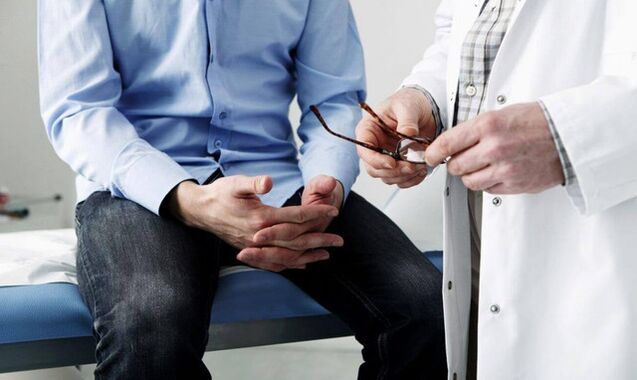According to statistics, in different forms of prostatitis, half of all men of the planet is diagnosed, starting from the age of twenty.To identify and timely treatment of prostatitis, it is necessary to know its symptoms.
The main symptoms
- Far -hearted urination.This is the most important sign of prostatitis.Pain and carving are possible during urination, low urine discharge with frequent calls.
- Pain.It can be disturbed in the lower back, in the crotch area, in the basin.It can be accompanied by urination, ejaculation, especially after a long break.
- Violation of potency.The weakening of sexual desire, weak erection, accelerated ejaculation is characteristic.
- Discharge.Purulent or transparent discharge from the urethra with the presence of white threads and flakes are possible.

The first symptoms
With the first symptoms of the disease, men can feel weakness, chills, breaking in the body, experience headache, and an increase in temperature is possible as with a cold.Irritability appears, sleep disturbance.Men do not pay much attention to such signs, but when adding to these symptoms of disorders in urination, it is worth thinking about inflammation.
Attention!The listed symptoms indicate the initial stage of prostatitis.
If treatment is not started in this period, more pronounced symptoms associated with the genitourinary system appear:
- Incomination of difficulty urinating with small urine secretions, a feeling of incomplete emptying.
- Changing the transparency of urine, with possible impurities of mucus and pus.
- Pain in the scrotum, groin, on the head of the penis.
- Carving, pain during urination.
- Soreness when intestinal emptying, pulling pains in the anus and in the lower abdomen.
- Reduced potency, accelerated ejaculation.
Depending on the form of prostatitis, it is acute and chronic
Chronic prostatitis
This form of the disease may not be seen in time due to the absence or insignificance of symptoms.The disease progresses slowly, for months and years may not disturb men.Chronic prostatitis is characterized by the following symptoms:
- Frequent mood changes, irritability.
- Discomfort in the perineum.
- Violation of urination.
- A slight decrease in erection.
Several times a year, chronic prostatitis is aggravated, as a rule, in the spring-autumn and winter periods.Then the above features become more pronounced.

Attention!In the absence of treatment, chronic prostatitis can give complications in the form of prostate adenoma, especially in older men.
Acute prostatitis
The rapid development of the disease is characteristic, in which the following symptoms can be quickly detected:
- General weakness with a possible increase in temperature.
- Pain in the muscles of the back and lower back, giving to the legs.
- Frequent urges with difficult and small urine release.
- Partial or complete decrease in potency.
Depending on the causes of the disease, bacterial and stagnant prostatitis are distinguished.
Bacterial prostatitis
This type of prostatitis is found in approximately 10% of cases and is characteristic of young men.The cause of the disease is infection with microorganisms: E. coli, protrude, golden staphylococcus.
The following signs are characteristic:
- Elevated temperature, chills.
- Pain in the genitourinary system, in the anus, crotch, back and lower back.
- Frequent and difficult urination, accompanied by a razor.
- Deterioration of potency.
Stagnant prostatitis
It occurs in case of circulatory disorders in the pelvis and the absence of a full -fledged sexual life.
Sustainable prostatitis is characterized by mild symptoms:
- Painful sensations of the inguinal region, testicles.
- Violation of urination.
- Elevated temperature.
- Depression and irritability.
- Problems with potency.
But, the absence of inflammatory signs in the composition of urine, seed fluid, the secret of the prostate gland is characteristic.
Important:All of the listed symptoms do not necessarily manifest itself together and for all sick people.Each man may have different signs of prostatitis in a different period of the disease.
The presence of one of all the above symptoms is a signal for seeking a doctor to diagnose the disease and timely treatment.



























